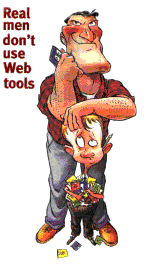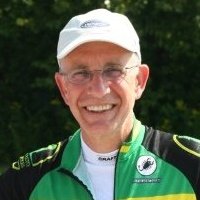 Phrase shamelessly borrowed from the 1980s book,
Real Men Don't Eat Quiche
Phrase shamelessly borrowed from the 1980s book,
Real Men Don't Eat Quiche
|
A little history about this graphic …
I ran one of the first websites inside cisco systems in the mid
90s. One day I downloaded the Apache HTTP Server v0.9, installed
it onto the Sun SparcStation on my desk, and started handcoding
HTML pages. The main browser in use at that time was Mosaic
which was able to interpret a large subset of HTML. However,
the scope of HTML at that time was fairly narrow since it was
targeted primarily at document sharing. This was the main use
at CERN from whence the whole World Wide Web came. (
Ted Nelson
,
Project Xanadu
,
and
Computer Lib
notwithstanding! ) Several other engineers in cisco were
also starting to download and install Mosaic on their desktop
systems and becoming web-enabled. This made CERN-style document
distribution and sharing a possibility within the engineering
organization at cisco.
I was the architect and technical lead of cisco's enterprise
(i.e. IBM) networking group at that time and I thought this new
medium would be a great way to share technical content with my
engineering and marketing colleagues. That idea caught on
quickly and my desktop system became an indispensible part of
content distribution around cisco's internal enterprise
networking team.
[†]
In the late 1990s, web publishing tools such as HoTMetaL and
Cold Fusion were starting to appear on the market, but they were
relatively crude and did not allow the user full access to all
of the features of HTML. I had been a software developer for 25
years at that point and I was very comfortable coding. I saw
HTML as just another programming language. Since I didn't like
being constrained by the tools (programmers rarely do), I
continued to author all of my content by coding raw HTML pages.
One day I ran across this graphic that was obviously produced by
like-minded HTML coders so I grabbed a copy of it and put it
onto the home page of my website inside cisco.
I have tried various web publishing tools over the years and,
while they have improved dramatically, the good ones have been
very expensive. They have also lagged behind the markup
language itself and effectively made HTML features inaccessible
via the tools. So, I have stayed with coding raw HTML page for
the past 25 years.
I have kept up with the emerging HTML language enhancements over
the years: HTML 1.x, 2.0, 3.2, 4.0, and now HTML5. HTML5 is a
major change to the markup language, mostly in support of
multimedia content. I am reassessing my propensity for HTML
coding. I am hopeful that this will give me a better
perspective to evaluate whether the tools are now easier to use
than coding raw HTML. I want to make that decision before this
website gets much more content.
|


 ]
in 1999. Our job was over at that point and the business
unit was disbanded.
]
in 1999. Our job was over at that point and the business
unit was disbanded.